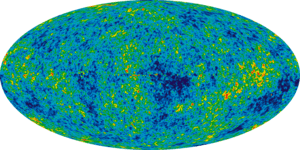Gravitational wave background
The gravitational wave background (also GWB and stochastic background) is a random gravitational-wave signal potentially detectable by gravitational wave detection experiments. Since the background is supposed to be random it is completely determined by its statistical properties such as mean, variance etc.
| Part of a series on | ||||
| Physical cosmology | ||||
|---|---|---|---|---|
 | ||||
|
Early universe
|
||||
|
Expansion · Future |
||||
|
Components · Structure
|
||||
| ||||
Sources of a stochastic background
Several potential sources for the background are hypothesized across various frequency bands of interest, with each source producing background with different statistical properties. The sources of the stochastic background can be broadly divided into two categories
Cosmological backgrounds arising from early universe sources (like some inflationary mechanism ), cosmic string theories etc. While these sources are more hypothetical a detection of a background from them would be a major discovery of new physics. The detection of such an inflationary background would have a profound impact on early-universe cosmology and on high-energy physics.
An astrophysical background produced by the confusion noise many weak, independent, and unresolved astrophysical sources [1]. For instance the astrophysical background from stellar mass binary black-hole mergers is expected to a key source of the stochastic background for the current generation of ground based gravitational-wave detectors. LIGO and Virgo detectors have already detected individual gravitational-wave events from mergers such black-holes. However there would be a large population of such mergers which would not be individually resolvable which would produce a hum of random looking noise in the detectors. Other astrophysical sources which are not individually resolvable can also form a background. For instance, a sufficiently massive star at the final stage of its evolution will collapse to form either a black hole or a neutron star – in the rapid collapse during the final moments of an explosive supernova event, which can lead to such formations, gravitational waves may theoretically be liberated.[2][3] Also, in rapidly rotating neutron stars there is a whole class of instabilities driven by the emission of gravitational waves.
The nature of source also depend on the sensitive frequency band of the signal. Current generation of ground based experiments like LIGO and Virgo are sensitive to gravitational-waves in the audio frequency band between approximately 10 Hz to 1000 Hz. In this band the most likely source of the stochastic background will be an astrophysical background from binary neutron-star and stellar mass binary black-hole mergers.[4]
Detection
On 11 February 2016, the LIGO and Virgo collaborations announced the first direct detection and observation of gravitational waves, which took place in September 2015. In this case, two black holes had collided to produce detectable gravitational waves. This is the first step to discovery of the GWB.[5][6]
References
- Joseph D. Romano, Neil. J. Cornish (2017). "Detection methods for stochastic gravitational-wave backgrounds: a unified treatment". Living Rev Relativ. 20 (1): 2. arXiv:1608.06889. Bibcode:2017LRR....20....2R. doi:10.1007/s41114-017-0004-1. PMC 5478100. PMID 28690422.
- Ott, Christian D.; et al. (2012). "Core-Collapse Supernovae, Neutrinos, and Gravitational Waves". Nuclear Physics B: Proceedings Supplements. 235: 381–387. arXiv:1212.4250. Bibcode:2013NuPhS.235..381O. doi:10.1016/j.nuclphysbps.2013.04.036.
- Fryer, Chris L.; New, Kimberly C. B. (2003). "Gravitational Waves from Gravitational Collapse". Living Reviews in Relativity. 6 (1): 2. arXiv:gr-qc/0206041. Bibcode:2003LRR.....6....2F. doi:10.12942/lrr-2003-2. PMC 5253977. PMID 28163639.
- LIGO Scientific Collaboration and Virgo Collaboration; Abbott, B. P.; Abbott, R.; Abbott, T. D.; Acernese, F.; Ackley, K.; Adams, C.; Adams, T.; Addesso, P.; Adhikari, R. X.; Adya, V. B. (2018-02-28). "GW170817: Implications for the Stochastic Gravitational-Wave Background from Compact Binary Coalescences". Physical Review Letters. 120 (9): 091101. doi:10.1103/PhysRevLett.120.091101.
- Abbott, B.P.; et al. (2016). "Observation of Gravitational Waves from a Binary Black Hole Merger". Phys. Rev. Lett. 116 (6): 061102. arXiv:1602.03837. Bibcode:2016PhRvL.116f1102A. doi:10.1103/PhysRevLett.116.061102. PMID 26918975.
- Castelvecchi, Davide; Witze, Alexandra (11 February 2016). "Einstein's gravitational waves found at last". Nature News. doi:10.1038/nature.2016.19361. Retrieved 11 February 2016.
